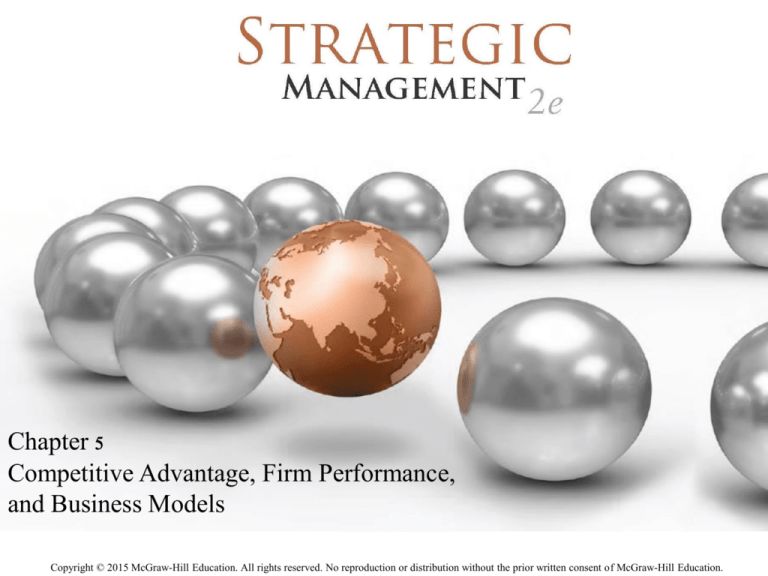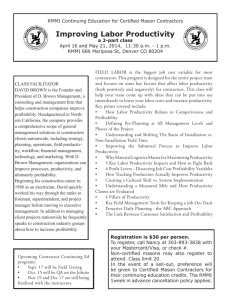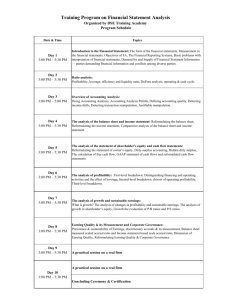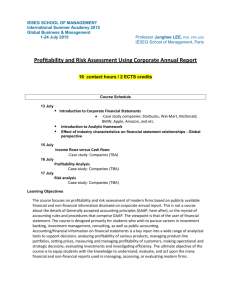
Chapter 5
Competitive Advantage, Firm Performance,
and Business Models
Copyright © 2015 McGraw-Hill Education. All rights reserved. No reproduction or distribution without the prior written consent of McGraw-Hill Education.
Chapter Outline
5.1 Competitive Advantage and Firm Performance
•
•
•
•
•
Accounting Profitability
Shareholder Value Creation
Economic Value Creation
The Balanced Scorecard
The Triple Bottom Line
5.2 Business Models: Putting Strategy into Action
5.3 Implications for the Strategist
5-2
ChapterCase 5
©STANCA SANDA/Alamy
Assessing Competitive Advantage: Apple vs. BlackBerry
2012 – A comparison of Apple vs. BlackBerry on
return on invested capital (ROIC), where ROIC = (Net
profits / Invested capital) reveals:
• Apple’s ROIC was 35.0%.
• BlackBerry’s ROIC was 14.1%.
Apple was 2.5 times more efficient than BlackBerry at
generating a return on invested capital, so Apple had a
clear competitive advantage over BlackBerry.
5-3
THREE TRADITIONAL FRAMEWORKS TO ASSESS
FIRM PERFORMANCE
ACCOUNTING PROFITABILITY
• What is the firm’s accounting profitability?
SHAREHOLDER VALUE CREATION
• How much shareholder value does the firm create?
ECONOMIC VALUE CREATION
• How much economic value does the firm generate?
5-4
5.1 Competitive Advantage and
Firm Performance
To measure competitive advantage, we must:
1. Assess firm performance and
2. Benchmark to the industry average / other competitors
Three performance dimensions:
• What is the firm’s accounting profitability?
• How much shareholder value does the firm create?
• How much economic value does the firm generate?
5-5
Accounting Profitability
Examining one of these – Return on invested capital
(ROIC), constituent parts are return on revenue and
working capital turnover.
2012 – Apple had a distinct competitive advantage over
BlackBerry because Apple’s ROIC was much higher
than BlackBerry’s.
Why is the ROIC for these two companies so different?
Apple vs. BlackBerry financial ratios are in Figure 5.1.
5-6
Accounting Profitability
LIMITATIONS
All accounting data are historical data and thus
backward-looking.
Accounting data do not consider off–balance sheet
items.
Accounting data focus mainly on tangible assets,
which are no longer the most important.
They do measure relative profitability, which is useful
when comparing firms of different size over time.
5-7
Exhibit 5.2
The Declining Importance of Book
Value in a Firm’s Stock Market Valuation,
1980−2010
5-8
THREE TRADITIONAL FRAMEWORKS TO ASSESS
FIRM PERFORMANCE
ACCOUNTING PROFITABILITY
• What is the firm’s accounting profitability?
SHAREHOLDER VALUE CREATION
• How much shareholder value does the firm create?
ECONOMIC VALUE CREATION
• How much economic value does the firm generate?
5-9
Shareholder Value Creation
Shareholders
• Individuals or organizations who own one or more shares
of stock in a public company
• The legal owners of public companies
• Effective strategies to grow the business can increase a
firm’s profitability and its stock price.
Risk capital
• The money provided by shareholders in exchange for an
equity share in a company.
• Cannot be recovered if the firm goes bankrupt
5-10
Total return to shareholders
• Return on risk capital, including stock price
appreciation plus dividends received over a
specific period
• This is what investors are interested in.
• It is an external performance metric, unlike
accounting data.
Efficient-market hypothesis
• All available information about a firm’s past,
current state, and expected future performance is
embedded in the firm’s stock price.
5-11
Exhibit 5.3
Stock Market Valuations of
Amazon, Apple, Google, Microsoft, and Samsung
5-12
Exhibit 5.4 Apple’s Market Cap
(December 2011− April 2013)
5-13
Shareholder Value Creation
LIMITATIONS
Stock prices can be highly volatile, making it difficult to
assess firm performance, particularly in the short term.
Overall macroeconomic factors such as the unemployment
rate, economic growth or contraction, and interest and
exchange rates all have a direct bearing on stock prices.
Stock prices frequently reflect the psychological mood of
investors, which can at times be irrational.
5-14
THREE TRADITIONAL FRAMEWORKS TO ASSESS
FIRM PERFORMANCE
ACCOUNTING PROFITABILITY
• What is the firm’s accounting profitability?
SHAREHOLDER VALUE CREATION
• How much shareholder value does the firm create?
ECONOMIC VALUE CREATION
• How much economic value does the firm generate?
5-15
Economic Value Creation
A firm has a competitive advantage when it creates
more economic value than rival firms.
Economic value creation is the difference between a
buyer’s willingness to pay for a product/service and
the firm’s total cost to produce it:
• (V – C), where (V) = Value and (C) = Cost, also called
economic contribution
The amount of total perceived consumer benefits
equals the maximum willingness to pay.
5-16
Exhibit 5.5 Competitive Advantage:
Same
Cost as Firm A but Firm B Creates More Economic Value
5-17
Exhibit 5.7 Competitive Advantage and
Economic Value Created:
The Role of Value, Cost, and Price
5-18
From an economic context, strategy is about:
1. Creating economic value and
2. Capturing as much of it as possible
A large difference between V and C gives the firm
two distinct pricing options:
1. Charge higher prices to reflect the higher product value and
increase profitability, or
2. Charge the same price as rivals and gain market share
The strategic objective is to maximize (V – C), which
is the economic value created.
5-19
OPPORTUNITY COST
Opportunity costs – The value of the best forgone
alternative use of the resources employed
Accounting profitability – Relies on historical costs
Economic value creation – All costs are considered,
including opportunity costs
5-20
Economic Value Creation
LIMITATIONS
Determining the value of a good in the eyes of
consumers is not a simple task.
The value of a good in the eyes of consumers changes
based on income, preferences, time, etc.
To measure firm-level competitive advantage, the
economic value created for all products/services
offered by the firm must be assessed.
5-21
The Balanced Scorecard
HOLISTIC PERSPECTIVE OF FIRM PERFORMANCE
Balanced scorecard – Strategy implementation tool
that harnesses multiple internal and external
performance metrics in order to balance financial and
strategic goals
The four key questions are:
1.
2.
3.
4.
How do customers view us?
How do we create value?
What core competencies do we need?
How do shareholders view us?
5-22
Exhibit 5.8
A Balanced-Scorecard Approach to
Creating and Sustaining Competitive Advantage
5-23
ADVANTAGES OF THE BALANCED SCORECARD
Communicate and link the strategic vision to
responsible parties within the organization
Translate the vision into measureable operational
goals
Design and plan business processes
Implement feedback and organizational learning in
order to modify and adapt strategic goals when
indicated
5-24
DISADVANTAGES OF THE BALANCED SCORECARD
It is a tool for strategy implementation, not for strategy
formulation.
It provides only limited guidance about which metrics
to choose−different situations call for different metrics.
Failure to achieve competitive advantage is not
indicative of a poor framework but of strategic failure−
i.e., managers must have crafted a strategy that builds
competitive advantage.
Managers must accurately translate their strategy into
objectives that can be measured within this model.
5-25
Strategy Smart Videos
Test Your Awareness: Do the Test
http://www.youtube.com/watch?v=Ahg6qcgoay4
1:09 Minutes
Topics: Balanced Scorecard; Big picture; Quantitative vs.
qualitative data. Students love this video.
5-26
The Triple Bottom Line
STAKEHOLDER PERSPECTIVE
Economic, social and ecological dimensions make up
the triple bottom line.
Noneconomic factors can have a significant impact
on a firm’s financial performance, as well as its
reputation and goodwill.
Extended producer responsibility – In anticipation of
government regulation – proactively addressing
social or ecological issues
5-27
Exhibit 5.9 The Triple Bottom Line:
The Simultaneous Pursuit of Performance along Social, Economic, and Ecological
Dimensions Provides a Basis for a Sustainable Strategy
5-28
CORPORATE SOCIAL RESPONSIBILITY
Historically, economic performance has been the focus of
firm performance.
More recently, society and investors require companies to
also address social and ecological concerns.
Millennials – born between 1980 and 1991 – expect firms
to be socially responsible and have a strong interest in
working for companies that match their values.
Research studies – CSR and firm performance
relationship:
• Some find CSR improves financial performance.
• Others conclude superior financial performance makes CSR
possible.
5-29
5.2 Business Models:
Putting Strategy into Action
Business model – Plan that details the firm’s
competitive tactics and initiatives
A business model explains how the firm intends to
make money, and how the firm conducts its business
with buyers, suppliers, and partners.
Business model innovation may be more important
in achieving superior performance than product or
process innovation.
5-30
Effective Business Model – Two Steps
1. Formulate
Managers transform their strategy of how to compete into a blueprint of
actions and initiatives that support the overarching goals.
2. Implement
Managers implement this blueprint through structures, processes,
culture, and procedures.
If translation into a profitable business model fails, the
firm will most likely fail.
5-31
Different Business Models
Razor–Razor-Blade
• Developed by Gillette – The initial product is often sold at a
loss or given away for free in order to drive demand for
complementary goods.
Subscription-Based
• Users pay for access to a product /service during the payment
term.
Examples: cable television, cellular service providers, satellite radio,
Internet service providers, and health clubs
See Dollar Shave Club subscription-based example in notes and video
link on next slide.
5-32
DIFFERENT BUSINESS MODELS
Pay-As-You-Go
• The user pays for only the services he or she consumes.
Freemium = free + premium
• The basic features of a product/service are provided free of
charge, but the user must pay for premium services such as
advanced features or add-ons.
5-33
5.3 Implications for the Strategist
COMPETITIVE ADVANTAGE AND FIRM PERFORMANCE
No One Best Strategy
• Only better strategies – Relative to competitors or industry average
Goal of Strategic Management
• Integrate and align each business function and activity to obtain
overall superior performance.
Quantitative and Qualitative
• Holistic perspective is required for performance assessment,
measuring different dimensions over different times.
Business Model
• How a firm does business is more critical to its competitive
advantage, than what it does.
5-34









